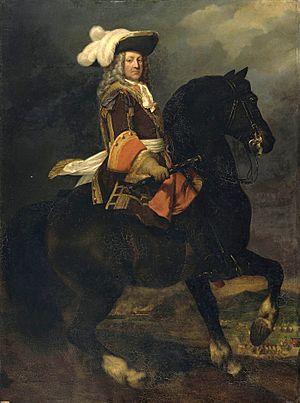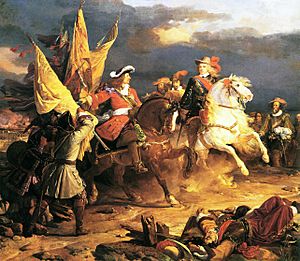Louis Joseph, Duke of Vendôme facts for kids
Quick facts for kids Louis Joseph |
|||||
|---|---|---|---|---|---|
| Duke of Vendôme | |||||

Portrait by Hendrik Scheffer
|
|||||
| Born | 1 July 1654 Paris, France |
||||
| Died | 11 June 1712 (aged 57) Vinaròs, Spain |
||||
| Burial | El Escorial, Spain | ||||
| Spouse |
Marie Anne de Bourbon
(m. 1710) |
||||
|
|||||
| House | Bourbon-Vendôme | ||||
| Father | Louis, Duke of Vendôme | ||||
| Mother | Laura Mancini | ||||
| Religion | Roman Catholicism | ||||
| Signature | |||||
Louis Joseph de Bourbon, Duke of Vendôme (born July 1, 1654 – died June 11, 1712) was a famous French general. He was also a Marshal of France, which is a very high military rank. People often just called him Vendôme. He was one of the best generals of his time. He served King Louis XIV and helped France win many battles during the War of the Grand Alliance and the War of the Spanish Succession.
Vendôme joined the French Army when he was young. He quickly showed he was a skilled fighter. In 1688, he became a Lieutenant General because of his bravery in the Franco-Dutch War. He got his first army command in 1695. Soon after, he was made a Marshal of France.
Vendôme was known for being very brave and a strong leader. His soldiers trusted him and fought hard for him. He helped the House of Bourbon family keep the throne of Spain.
Life Story of Louis Joseph

Louis Joseph de Bourbon was born in Paris, France. His father was Louis, Duke of Vendôme, and his mother was Laura Mancini. When he was fifteen, his parents had both passed away. He inherited a large amount of money from his father's side of the family. Before he became the Duke of Vendôme in 1669, he was known as the Duke of Penthièvre. His aunt, Marie Anne Mancini, helped raise him.
Louis Joseph joined the army when he was eighteen. He quickly showed his courage in wars in the Netherlands. By 1688, he was a lieutenant-general. During the Nine Years' War, he fought bravely. He served under famous generals like the Duke of Luxembourg at the Battle of Steenkerque. He also fought under Nicolas Catinat at Marsaglia. In 1695, he took charge of the army in Catalonia, Spain. There, he captured the city of Barcelona in 1697.
Soon after these victories, Vendôme became a Marshal of France. In 1702, he was put in charge of the French and Spanish army in Italy. This was during the War of the Spanish Succession. For three years, he fought against the skilled general Prince Eugène of Savoy. In 1705, Vendôme finally defeated Prince Eugène at the Battle of Cassano. He showed great courage and leadership, turning a difficult situation into a big win.
The next year, he won another battle at Calcinato. After this, he was sent to Flanders (modern-day Belgium) to help the French army. They had suffered a big loss at the Ramillies. While Vendôme was in Flanders, Prince Eugène and the Duke of Savoy defeated the French army in Italy. This forced the French out of Italy. In Flanders, Vendôme had disagreements with the king's grandson, Louis, Duke of Burgundy. Because of this, he could not stop the French from losing at the Battle of Oudenarde.
Feeling disappointed, Vendôme went back to his home. However, he was soon called back to lead the army of his cousin, Philip V of Spain. There, he won his last battles. He had great victories at Brihuega and Villaviciosa. Louis Joseph died suddenly in Vinaròs, Spain, on June 11, 1712. He was buried at El Escorial in Spain.
Vendôme's Military Skills
Vendôme was one of the most amazing soldiers in French history. He was not only a clever army leader but also a very brave soldier. The main reason for his many successes was how well he connected with his soldiers. They trusted him completely. He rarely made mistakes. Even his opponent, Prince Eugene of Savoy, praised how brilliant some of Vendôme's actions were.
Marriage and Family
Vendôme married Marie Anne de Bourbon. She was the daughter of Henri Jules, Prince of Condé. Her grandfather was the famous general known as Le Grand Condé.
Marie Anne's father passed away, and she was still unmarried. Her brother, who became the Prince of Condé, also died without helping her find a husband. She could have married the Duke of Maine in 1692. But he chose to marry Marie Anne's sister instead.
Louis Joseph and Marie Anne were married on May 21, 1710. The ceremony took place at the chapel in the Château de Sceaux. Louis Joseph was 55 years old at the time. He was a Marshal of France. He was also chosen to be the heir of his cousin, King Philip V of Spain. This meant that if Philip died without children, Louis Joseph would become the next king of Spain. However, Louis Joseph and Marie Anne did not have any children. Marie Anne died in 1718.
Even though King Louis XIV had given permission for the marriage, the Duke and Duchess of Maine quickly arranged the wedding details. They probably did this for their own benefit. Many important family members were present at the wedding.
When Louis Joseph died, he left his wife the duchy of Étampes and its lands. She held this title herself. When she passed away, the title went to her niece, the Princess of Conti.
See also
 In Spanish: Luis José de Vendôme para niños
In Spanish: Luis José de Vendôme para niños

